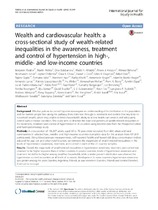Wealth and cardiovascular health: a cross-sectional study of wealth-related inequalities in the awareness, treatment and control of hypertension in high-, middle- and low-income countries
Date
2016Author
Palafox, Benjamin
McKee, Martin
Balabanova, Dina
AlHabib, Khalid F.
Avezum, Alvaro Jr.
Bahonar, Ahmad
Tsolekile, Lungiswa P.
Metadata
Show full item recordAbstract
BACKGROUND: Effective policies to control hypertension require an understanding of its distribution in the population
and the barriers people face along the pathway from detection through to treatment and control. One key factor is
household wealth, which may enable or limit a household’s ability to access health care services and adequately
control such a chronic condition. This study aims to describe the scale and patterns of wealth-related inequalities in
the awareness, treatment and control of hypertension in 21 countries using baseline data from the Prospective Urban
and Rural Epidemiology study.
METHODS: A cross-section of 163,397 adults aged 35 to 70 years were recruited from 661 urban and rural
communities in selected low-, middle- and high-income countries (complete data for this analysis from 151,619
participants). Using blood pressure measurements, self-reported health and household data, concentration indices
adjusted for age, sex and urban-rural location, we estimate the magnitude of wealth-related inequalities in the
levels of hypertension awareness, treatment, and control in each of the 21 country samples.
RESULTS: Overall, the magnitude of wealth-related inequalities in hypertension awareness, treatment, and control was
observed to be higher in poorer than in richer countries. In poorer countries, levels of hypertension awareness and
treatment tended to be higher among wealthier households; while a similar pro-rich distribution was observed for
hypertension control in countries at all levels of economic development. In some countries, hypertension awareness
was greater among the poor (Sweden, Argentina, Poland), as was treatment (Sweden, Poland) and control (Sweden).
CONCLUSION: Inequality in hypertension management outcomes decreased as countries became richer, but the
considerable variation in patterns of wealth-related inequality - even among countries at similar levels of economic
development - underscores the importance of health systems in improving hypertension management for all.
These findings show that some, but not all, countries, including those with limited resources, have been able to
achieve more equitable management of hypertension; and strategies must be tailored to national contexts to
achieve optimal impact at population level.

